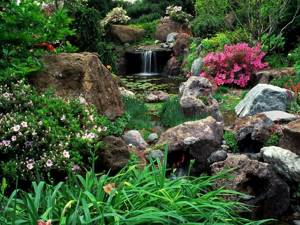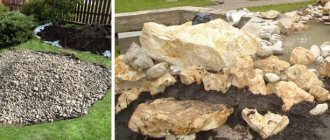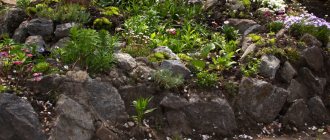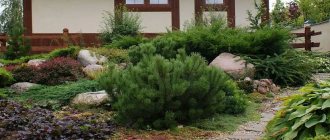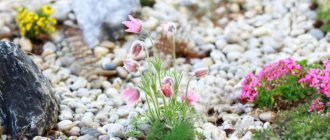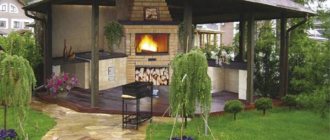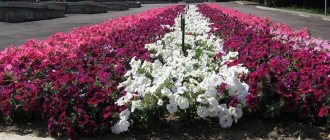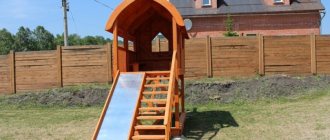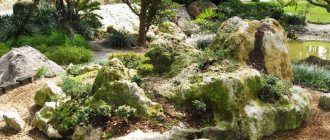- Alpine slide: how to make it yourself
- What is an alpine slide and its features
- Alpine slide in the country: varieties of compositions
- What is the difference between an alpine slide and a rock garden?
- Alpine slide in the country: choosing a location
- Alpine slide at the dacha: planning and preparatory work
- Alpine hill in the country: choosing plants for planting
- Scheme of planting alpine hill plants at a summer cottage
- Rock garden in the garden: choice of stones, installation options
- Alpine slide in the country: step-by-step installation of a classic rock garden
- Alpine slide irrigation system
- Decorative design of an alpine slide
- Alpine slide with pond
- Illumination of an alpine slide at the dacha
- Setting up an area for reading or drinking tea
- Rules and care tips
- Video: do-it-yourself alpine slide
Alpine slide: how to make it yourself
Alpine slides are increasingly appearing on personal plots, squares, and recreation areas. The landscape composition of boulders, a waterfall, and plants resembles a piece of a mountain landscape that delights with bright blooms from spring to autumn. The combination of rough rocks and delicate flowers, emerald grass creates a feeling of serenity and a piece of exotic wild nature.
To decorate a small rock garden, you can use limestone.
To independently build an alpine slide at your dacha, you don’t need the skills of a landscape designer, just enough patience and physical strength to lay out rocky structures and plant flowers. You can see interesting solutions in photographs, and then adapt them to the landscape and site design. Creating a rock garden with your own hands is an exciting process; as the hill becomes populated with vegetation, new ideas appear, the landscape composition is complemented by lamps and clay pots.
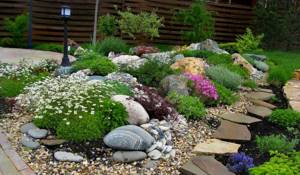
Rockery is a picturesque garden composition consisting of stones and decorative low-growing plants.
Alpine slides are increasingly appearing in garden plots, public gardens, and recreational areas. The landscape composition of boulders, a waterfall, and plants resembles a piece of a mountain landscape that delights with bright blooms from spring to autumn. The combination of rough rocks and delicate flowers, emerald grass creates a feeling of serenity and a piece of exotic wild nature.

Multi-level alpine slide with stones.
To independently build an alpine slide at your dacha, you don’t need the skills of a landscape designer, just enough patience and physical strength to lay out rocky structures and plant flowers. You can see interesting solutions in photographs, and then adapt them to the landscape and site design. Creating a rock garden with your own hands is an exciting process; as the hill becomes populated with vegetation, new ideas appear, the landscape composition is complemented by lamps and clay pots.
Time to collect stones
Of particular importance are the stones, which will serve as both a construction and a decorative element for the slide.
Their selection should be approached with special attention, and experts advise giving preference to rocks with low porosity.

These include sandstone, granite or basalt. Rocks such as tuff or shell rock absorb water quite quickly, which leads to their relatively rapid destruction.

As for the shape of the stones selected for construction, it is better to look for a middle ground.

If you look at a photo of an alpine slide made by yourself, you will notice that the most pleasant-looking options are the ones in which the boulders are not too round, but at the same time not too angular and sharp. All stones must be of the same type.

What is an alpine slide and its features
An alpine hill is an earthen embankment with stones of various shapes laid in tiers, between which shrubs and low-growing flowers grow. The artificially created relief imitates the elements inherent in mountainous areas - plateaus, slopes, cliffs.

Stone is the main element of a rock garden.
To reproduce a copy of the alpine landscape, a stone flowerbed is planted with mountain plants. This botanical extreme is not adapted to local conditions, so it is often replaced by local tulips, crocuses, lingonberries, and periwinkle. A rock garden differs from a rock garden in that it has a flat surface and a large number of stones. The rocky and gravel area is formed on flat terrain and can be located over an area of several tens of meters. Externally, the rockery is close to the landscape of the middle zone; it is planted with steppe and forest vegetation.

A stable rock garden is created for many years.
Rock garden flowers, or following logic and impeccable taste
So, an alpine slide in your garden is a miniature of the Alps and their lawns. Where have you seen large trees and dense plantings in alpine landscapes? That's right, we didn't see it, because the decoration of the gentle slopes of the Alps are creeping plants, mosses and lichens, ground cover or bright flowers of small height, dwarfs.

Therefore, if your site allows it, and you want to recreate on it a piece of a birch grove, a mixed forest, and an impenetrable spruce forest in the Russian style, do it on the periphery of the site, and leave the central part for the alpine hill so that it shines on its territory during in all its glory. In this case, select the following plants for her:
- ground cover: mosses, sedums, lichens. They can decorate any tier of the slide, but it is worth remembering that they can get “lost” among other plants. Leave for them a certain zone, which from early spring until the last days of autumn will be expressed in emerald greenery, gray velvet, frost and other interesting shades (rock alyssum, Caucasian moss, gray fescue, felt grass);
- young of various shapes and colors. They will delight you with the splendor of their buds and the shades at the ends of the petals, and in mid-summer - with interesting thick stems-inflorescences;
- perennial flowers of dwarf species. Phlox, decorative violets, daffodils and even tulips are appropriate here;
- annual flowers. Petunia and gazania, salvia and ranunculus, tagetis and Chernobrivets will create the mood in the rock garden, becoming bright inclusions that can slightly “blur” green and dove, light green and chocolate, and other other colors.
In addition, their height will play a significant role in choosing plants for the next season. Inspecting the composition, noticing the details, you will see that, for example, the hosta was planted very high and shades the saxifrage, and the low-growing thyme has grown together with the aubrieta and became a single purple background at the time of flowering. And there are dozens of such examples. Therefore, to create a harmonious alpine slide, which will ideally combine colors, shades and halftones of burgundy and red, orange and lemon, olive and terracotta, you need to draw a small sketch with the names of the planted plants. By changing one flower to another over a couple of seasons, observing them, you will soon fill the entire rock garden with your favorite flowers and greenery, which form a harmonious beginning, a focal point for unifying the style.
Alpine slide in the country: varieties of compositions
Rock gardens differ in their relief; before starting to create a picturesque area, you need to take into account the landscape features of the local area or park area.
| View | Peculiarities | Recommendations |
| mountain wall | Used in the construction of terraced slopes. Flowers and creeping junipers are planted in niches and recesses left in the stonework and filled with soil. | After creation, the wall is watered generously from a spray bottle until the plants take root. |
| rocky hill | Small stones are placed at the base of the embankment, the top is created from large fragments, and alpine plants are planted | A slide of boulders and layered stones is combined with paved paths and lawns |
| Gorge in the mountains | In a small ditch or hollow, stones of different heights are laid out along the slopes, and plants are planted between them. | The landscape composition is suitable for areas with natural ravine terrain and two slopes. To strengthen the ravine, boulders are dug into the ground |
| mountain valley | Stones are buried three-quarters of the way into the ground, paths are laid, a grass carpet is created, and shrubs are planted. | An abundance of herbs and flowers can be complemented by a fountain or small pond |
| rock cliff | They recreate the breaks in the mountainous terrain with the help of stone fragments, the cliff is planted with crassula, creeping plants | Work begins at the base of the slope, the boulders are pressed tightly together |
| Mountain Creek | The bottom of the stream is covered with river stones, pellets are laid along the banks, and moisture-loving plants are planted. | Ferns with wide feathery leaves planted near a stream create the effect of wild nature. |
| Alpine garden | The garden is laid out on an inclined or flat surface, using a minimum of stones | The emphasis is on shrubs and bright plants |
| Japanese motives | They create the appearance of a collapsed rock, the picturesque area is decorated with basalt, tuff, the area at the base is decorated with perlite, fine gravel | The style of plants in gray, yellow-brown shades, muted red colors, and dwarf shrubs of asymmetrical shape are emphasized |
| Mini rock garden | A hole in a large trunk, a ceramic container, a basin are filled with earth, small stones, sedums, grains, and armeria are planted | Pre-make water drainage and drainage |
Construction of the slide
The construction of the slide is of no small importance. This design can be done in different ways
rocky slope
This option is characterized by a rocky shape, which is mainly made of stones. Plants are planted among them.
Terraced slope
This composition is characterized by protrusions at different heights. They are made using retaining walls. Buildings can have different configurations.
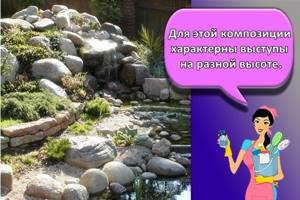
mountain gully
This area is characterized by stones of different sizes. They protrude from the ground. The boulders are supplemented with plants with a long flowering period.
Gorge
When constructing it, it is worth taking into account the terrain. Stones are used to decorate the slopes. At the same time, ground cover crops are planted on the hill.
Czech rolling pin
This is a multi-tiered hill that includes flat stones. They are folded vertically. Decorative crops are planted nearby.
Valley in the mountains
The structure is made of large stones, which are partially immersed in the ground. The composition is complemented by lushly flowering crops.
What is the difference between an alpine slide and a rock garden?
If you are just beginning to discover the secrets of landscape design, it may seem that an alpine slide and a rock garden are one and the same. The presence of stones and wild plants, compliance with the natural appearance is present in both options. What's the difference?

Depending on the location, all rock gardens are divided into flat (horizontal) and terraced (volumetric).
The construction of a rock garden requires a lot of effort, since the plants are dominant in it. Stones in an alpine hill play a secondary role. Their task is to highlight the diversity of plants and make a hint of the natural mountainous area. Photos of step-by-step do-it-yourself alpine slide instructions presented online will help you get acquainted with the features of its construction.
In a rock garden, the dominant element is the stone. It is the combination of its rocks, textures and colors that creates the overall atmosphere of a stone garden. The plants here are intended only to dilute its severity and coldness.
Stones: which ones and where to get them
The basis of any type of slide is stones and you will need a lot of them - several tons, and of different sizes. Choose from those breeds that are more common in your area. Chopped blocks look best, but already aged, with dark edges. You can also use pellets with smooth sides, but creating a natural composition from them is not an easy task. You will need about one fourth of a large size, about the same amount of a medium size - the rest are small stones.
Granite looks great. But it is hard and “cold”; even the most tenacious saxifrages can rarely grow on it, and the soil next to it quickly acidifies. This should also be kept in mind and periodically adjust the acidity (or plant plants that love acidic soil).

Stones in the form of slabs look good on low slides
It is best to use tuff. It drains water well, water flows through it well, and what’s even more important is that plants grow well right on it
What’s also important is that it neutralizes acidity, which the “Alpines” like.
Lime slabs are also good, but they come in slabs; they are good for decorating alpine plains or very low and gentle hills.
Alpine slide in the country: choosing a location
The rock garden on the site is a central element that should be clearly visible and in harmony with garden paths and other decorative details. It is unacceptable to have greenhouses, garden beds, or outbuildings near the picturesque area. The most successful places for landscape composition are lawns, slopes, hollows, small hills that are located near recreation areas and are isolated from the wind.

Creating an alpine slide is a creative process, and each designer puts a piece of his soul into it.
Areas with high groundwater levels have a negative impact on plants and the stability of stone structures. To remove moisture, create a drainage pond that will drain the water and complement the stone flower garden.
Alpine flora is photophilous; it is advisable to locate the mountainous fragment on the eastern or southeastern side, where there are no shading trees. For a partially darkened area, you will have to select appropriate vegetation.

If the site has natural relief features in the form of slopes or ravines, they can be decorated with the help of volumetric rockeries.
Note! To prevent the rock garden from losing its attractiveness, watering facilities should be located nearby.
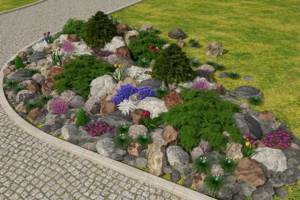
Basic rules for placing stones
A lot depends on the location of the stones. Do not pile up stones and plant plants between them. The design should be harmonious. If there is no harmony, then the structure can be considered useless, because the abundance of flowers and stones will make your eyes run wild.
To make the design beautiful, the following rules must be observed: Each type of stone must be the same size. But you should not choose more than 3 types;
There is no specific place where the stones should be placed. It all depends on your imagination. You can make simple patterns or creative inscriptions from stones. Large stones can be placed in the middle or along the edges.
The huge stones that are placed throughout the entire area of the rock garden look very unusual. The hill, which is crowned with a huge granite boulder, looks unusual. You can plant beautiful green plants near it.
Alpine slide at the dacha: planning and preparatory work
The developed project will help to accurately mark the site and plan the work. On paper you need to schematically indicate the main elements with dimensions. Preparing the base for an alpine slide consists of several stages:
- the diagram is transferred to the site, the contours are marked, the turf is removed with a thickness of at least 40 cm;
- to protect against excess moisture and gas exchange, form a cushion of 10-20 cm of crushed stone and broken brick;
- the surface is covered with a 5-10 cm layer of coarse sand and watered; a mixture of fertile soil, wood chips, humus, and fine gravel is placed and compacted onto the prepared drainage.
These stages cannot be ignored; drainage not only normalizes the moisture balance, but also works as a foundation. A stone flower garden will not sag over time.

A bright rock garden, arranged on a personal plot.
Note! In places where massive stone fragments will be placed, large fragments of brick are laid and compacted tightly.
Rockery and rock garden: similarities and differences
These concepts are often confused even by experienced gardeners. This is not surprising, because they do have many similar characteristics. The basis of rock gardens and rockeries is the use of stones and plants.
A rockery is an ensemble made mainly of stones alone. This is a classic approach to creating a rock garden. Various flowers act only as a background element for the stone rocks.
Rock garden is a man-made hill with stones, planted with flowering plants and small shrubs in the form of tiers. The hill is decorated with Alpine and Carpathian plants, but in the Japanese version Far Eastern species are planted, and in the Mexican version - succulents.

A rockery is a composition of stones, created, as a rule, on a flat relief. It consists of rocks of different sizes, gravel fill and sand. Rare plants are usually the focal point of the entire ensemble. The Japanese rockery can do without plants at all.
A rock garden differs from a rock garden by the obvious unevenness of the relief, because the rock garden is located on a plane. Among its varieties, there are three main style directions:
- Japanese rock garden. It is a composition of stones, where plants play a secondary role and act as color accents. This option will appeal to lovers of peace and harmony.
- A European-style rock garden is as close as possible to the natural landscape.
- The English rockery is distinguished by perennial coniferous shrubs that are so loved by the inhabitants of England
In addition to styles, rockeries can be divided into temporary, permanent and changeable.
A temporary rock garden is organized on a flat or slightly raised area. It is planted with small seedlings that will soon become lush plants. The planting scheme should be drawn up according to the size of adult individuals. Rocks and mounds can be changed as flowers and shrubs grow. The most massive and spectacular boulders are usually reserved for growing plants.
If you don’t plan to pay much attention to the rockery in the future, then the so-called “permanent” rockery will be interesting. Its construction will require large boulders or smaller stones for their grouping. The rock garden is divided into small zones, which are marked with stones. Such zones will help curb excessive plant growth and keep each plant in its place. The slowest growing and easiest to care for will be coniferous plants and low-growing shrubs such as spirea, cinquefoil or barberry.
The changeable rockery is based on planting new plants every year, with the exception of a few large and permanent individuals that will form the basis of the composition. This variety will ensure dynamics and a change of scenery every year.
Alpine hill in the country: choosing plants for planting
For an alpine hill, vegetation with different flowering periods and slow growth is selected. Not all alpine plants take root well, so landscape designers often use representatives of forest and steppe flora.

The rock garden should fit harmoniously into the surrounding landscape.
The basis of the composition is made up of low-growing juniper, mountain pine, thuja, fern, blueberry, and lingonberry. The flowerbed is filled with lavender, fescue, marigolds, bergenia, chickweed, and periwinkle. A cushion of Moricia and grains looks beautiful around rocky structures. Sunflowers and phlox are planted in the middle rows.

Plants planted directly into the recess of a large boulder look very impressive.
Medicinal and spicy herbs get along with stones: lovage, basil, thyme, sage, oregano, mint. You can place indoor crops in pots between the stones. During the summer holidays, pelargonium, indoor roses, hydrangea, hippeastrum, and aloe are transported to the yard and dacha. Moss gives a natural appearance to mountainous fragments.
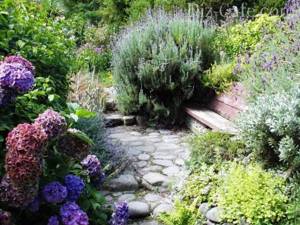
A classic rock garden is populated with plants characteristic of rocky slopes, alpine meadows, and highlands.
- winter-hardy and unpretentious Boyd's willow with fluffy leaves is combined with creeping coniferous shrubs and flowering perennials, does not grow to the sides;
- cotoneaster bushes with small white inflorescences and red fruits survive well on artificial embankments;
- Erica blooms from early spring to October;
- Canadian derain creates a white and green carpet on the alpine hill;
- the miniature joster tree looks beautiful against the background of stones;
- creeping evergreen euonymus take root in shaded areas.
For the rock garden, unpretentious flowers are chosen: echinacea, alpine carnation, rock alyssum, young, haretail. Capricious edelweiss and rock bells are difficult to care for.
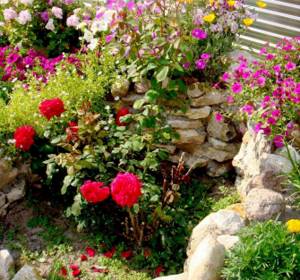
What is a rock garden
The mound of stones and plants is very similar to an alpine mountain landscape in miniature. To make the composition natural, a suitable option would be an elevation of three tiers with flower beds, with a flowing stream or water source at the foot.
Types of alpine slides
The future design of the alpine slide depends on the chosen type. There are many options, including:
Rocky slope. It has a rocky appearance, built mainly from stones, among which alpine plants are rarely planted.
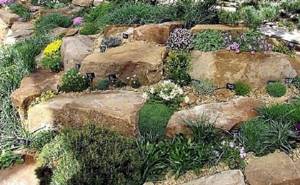
rocky slope
Mountain slope. This is a complex, combined composition. It uses stones of various sizes. The mountain slope is high; creeping and low-growing crops are used to decorate it. An artificial waterfall can be installed in this building.
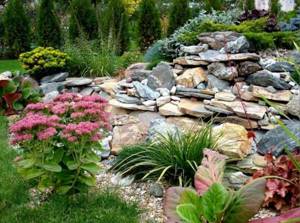
mountain slope
Terraced slope. A composition with protrusions at different heights, which are lined up using retaining walls. Such buildings differ in configuration and length.
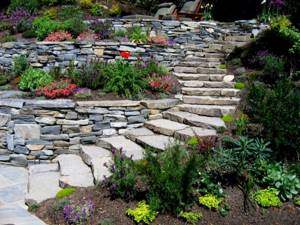
Terraced slope
A hill of stones. One of the most difficult buildings to construct. The composition harmoniously combines low-growing perennial plants and large boulders.
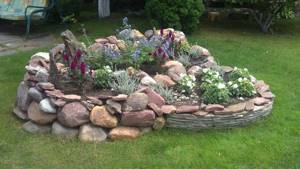
Hill of stones
Mountain hollow. This is an area with different sizes of stones protruding from the ground. The boulders are diluted with plants that have a long flowering period.
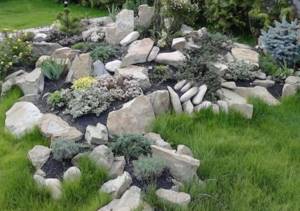
mountain gully
Gorge. During construction, the terrain is taken into account. The slopes are decorated with stones; the flora in this rock garden is represented by any ground cover plants. This composition is often built with an artificial pond.

Gorge
Czech rolling pin. A multi-tiered hill made of flat, vertically stacked stones. Alpine plants are planted next to the building.
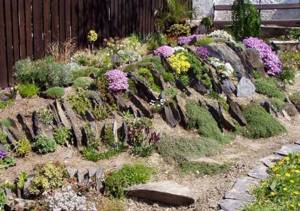
Czech rolling pin
Valley in the mountains. Looks like a mountain valley. Constructed from large stones immersed (partially) in the soil. The composition is complemented by asymmetrically arranged plants that bloom profusely.

Valley in the mountains
Alpine lawn. This is a stylish mound of stones with plants from the highlands. It is assumed that there is a fountain or pond.

Scheme of planting alpine hill plants at a summer cottage
Visually, the rock garden is divided into tiers, each level is filled with vegetation with similar care conditions.
Tiered filling of an alpine hill with plants
| tiers | Recommendations | Plants |
| Upper | Light-loving grasses and flowers that are resistant to wind and lack of moisture are planted. | Iberis, young, edelweiss, creeping thyme |
| Average | Choose varieties growing in partial shade | Woolly chickweed, phlox, sunflower, alpine aster |
| Lower | The foot is decorated with shade-loving and moisture-loving crops | Rhododendrons, conifers, saxifrages |
Note! The rock garden begins to be planted with shrubs, conifers and tall plants that look impressive at the foot of large stones. Niches for heat-loving seedlings are insulated with fine expanded clay.
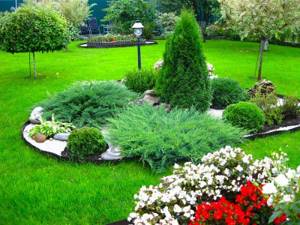
Conifers are the basic plants in rockeries.
How to build: step by step instructions
When building an alpine slide on a site, a certain sequence of actions is followed:
- After laying the drainage layer, mix the turf layer set aside in equal parts, humus, peat and sand. In this case, the turf is sifted or the rhizomes are carefully selected by hand.
- The largest and most beautiful stones-boulders are laid along the perimeter of the future slide. They must lie very stable; for this, if necessary, add small supporting stones. It is generally recommended to dig the bottom row of boulders one third into the ground in order not only to increase stability, but also to create a natural effect.
- Further work boils down to filling the center of the future alpine hill with a nutritious soil mixture and at the same time laying medium-sized stones, with the help of which the second tier is formed.
It should be remembered that when constructing a decorative structure, there should be enough space for planting plants and flowers. At the top of the slide, one large or two medium-sized cobblestones are installed to complete the composition.
Planting plants and flowers
When the soil in the alpine hill settles, they begin to plant ornamental vegetation. It should be selected not only based on aesthetic preferences, but also taking into account climatic conditions. In some cases, plants are even planted in pots and placed directly on a hill in them.
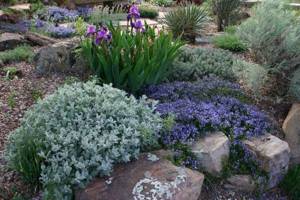
Boxwood
Boxwood is an ornamental plant characterized by slow growth. It tolerates pruning well, and the bush is easy to give the desired shape. Its compact size allows it to be grown even on small alpine hills. The plant does not have high frost resistance and needs special protection in winter. It is preferable to plant boxwood in a shady place.
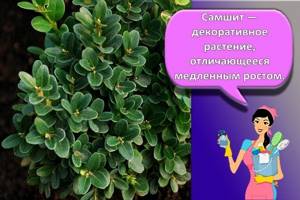
Thuja
Today, many varieties and varieties of thuja are known, but for the design of a rock garden, preference is given only to low-growing plants. Most of them have high frost resistance and are undemanding in care. Thujas decorate the site with their greenery all year round.

Juniper
If you want to plant perennials on an alpine hill, then you should not ignore juniper. In addition to its beautiful appearance, this plant will fill the air around it with an unusual pleasant aroma.
In this case, you should choose dwarf forms of evergreen shrubs.
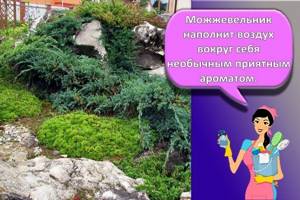
Erica herbaceous
A small evergreen shrub will delight the owners of rock gardens with beautiful flowering, which occurs at the very end of autumn or the beginning of winter. The plant is unpretentious and grows well. For Erica, you need to carefully select neighbors to create excellent compositions.
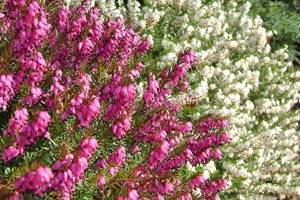
Saxifrage
Saxifraga is an unpretentious plant that even a beginner can care for. There are many varieties known, differing in the shape and color of flowers and leaves. Planting should be done in a slightly shaded place to achieve the best decorative qualities. Saxifraga does not tolerate temperature drops below -12 °C in winter.
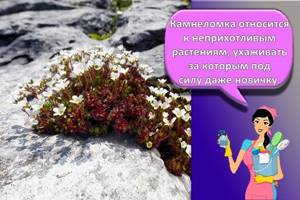
Phlox subulate
An amazingly beautiful ground cover plant with small flowers of various colors that exude a pleasant aroma. Flowering occurs at the beginning of June.
creeping thyme
You should definitely plant creeping thyme on the alpine hill. This is not only an ornamental, but also a medicinal plant, characterized by its unpretentiousness and low maintenance requirements. Now there are several varieties of creeping thyme, differing in the color of leaves and flowers, bred specifically for rock gardens.

Aubrietta
A herbaceous evergreen creeping flower that resembles a beautiful carpet. Decorative qualities are maintained throughout the year. There are several known species with different shades of flowers. The plant is unpretentious and does not require special care.
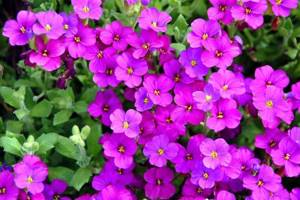
Lobularia
An ornamental plant that can be easily grown from seeds even by novice gardeners. Has a rich range of colors. It does not require special care. Only improper planting can lead to a decrease in decorativeness. Decorates the alpine hill with its flowering throughout the season.

When the creation of an alpine slide comes to an end, it is decorated with small stones, pebbles or crushed stone. You can use garden figures and lanterns as decoration.
Rock garden in the garden: choice of stones, installation options
To make the right choice, you need to know the degree of fragility and porosity of each rock. Sandstone - blocks with a coarse-grained structure are used not only for decorating an alpine hill, but also for planting shrubs with small roots. Granite is used in combination with conifers and heather shrubs.
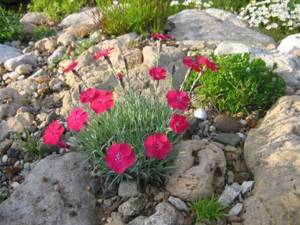
Alpine stone slide with bright flowers.
Tuff is suitable for high-mountain flora and is beautifully overgrown with lichens. The slate exfoliates into sheets and fits well into a mountain wall or ladder. Dolomite reduces soil acidity and is easy to process.
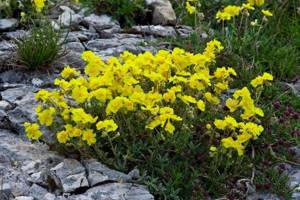
Plants for rockeries must be selected taking into account their flowering time.
The installation option depends on the type of alpine slide. To recreate the valley, the blocks are placed randomly. For a rocky wall, choose flat fragments of equal height, and compensate for unevenness with small stones. When laying a slide on a slope, the stones are placed parallel with a slight slope back.
Caring for decorative structures

The lifespan of the waterfall depends on how the waterfall is cared for.
To extend the life of a waterfall, it is necessary to provide it with proper care. The main activities are as follows:
- systematically add water to the tank as it evaporates;
- clean the water surface from accumulated debris (leaves, branches);
- add special anti-blooming drugs to the water;
- Aquatic plants are planted in the pond (if possible), which will not only decorate, but also purify the water;
- Clean the pump filters 2 times a month;
- drain the water for the winter;
- Regularly inspect the wires for damage.
Alpine slide in the country: step-by-step installation of a classic rock garden
The first tier is laid out from large blocks, the gaps are filled with small stones, and the empty space is covered with pebbles. For natural shrinkage, the rocky structure is formed in the fall. They think through the installation in advance so that it is easy to move along the hill for watering and weeding.

In voluminous rockeries it is customary to use rocks with a rough texture.
To create a natural effect, symmetry and uniformity are avoided. The first tier is laid out from large blocks, buried by a third of the volume. The gaps are filled with small stones, and space is left between them for plants. The laid row is covered with soil, compacted, and watered.
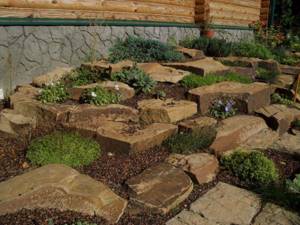
Decorative appeal is an important criterion when choosing stones for a rock garden.
Smaller stone fragments are placed in the next tiers. The top of the alpine hill is crowned with a large beautiful stone.
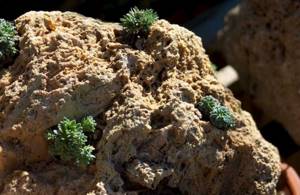
Note! To preserve naturalness, the rocky structure is constructed from one rock.
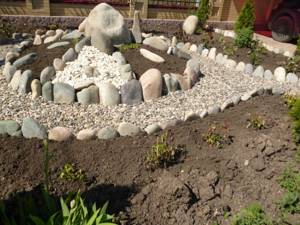
The use of pebbles, gravel, and crushed shale allows you to fill empty spaces and define the boundaries of the rock garden.
Alpine slide irrigation system
If the substrate is properly prepared and mulched, then the flower garden is watered only during the dry period. Mulch retains moisture and is added once a year. Cold water is suitable for alpine flora; flowering garden and indoor plants like warm watering. Drip irrigation will make caring for the rock garden easier.
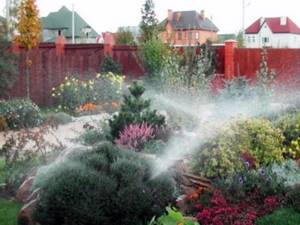
With the help of flat rockeries you can divide functional zones or hide unsightly places on the site.
The irrigation system can be quickly installed with your own hands from ready-made kits. The kit consists of micro-hoses with droppers, through which water flows from the storage tank to the roots. They develop better, the appearance of conifers improves, and the immunity of seedlings is strengthened. With drip irrigation, a crust does not form, and there is no increased evaporation, which harms flowering plants. The volume of water released can be adjusted by the control unit.
Decorative design of an alpine slide
Decor made from natural materials, artificial ponds, and lighting give the rock garden a unique look. The mountain landscape will be complemented by dry streams. With proper arrangement, it seems as if a stream of water has recently flowed along the dry riverbed. The source of the stream should come out from under a large block, the mouth should be hidden in green spaces and large leaves. The water surface is imitated with pebbles and fine gravel.

Initially, such masterpieces of landscape design were created only in high-status country villas by professional designers.
Alpine slide with pond
A pit is dug for the pond and the walls are insulated with butyl rubber film. A small pond can be made from a car tire or a special fiberglass liner, which is placed in a pit that follows the shape of the sides. For a stream flowing along a stone bed, a pump is installed in the pond and connected to a water supply hose. For the cascade, take flat stones, fasten them with polyurethane foam, and cover the seams with small fragments.

Saxifraga oppositeifolia is a ground cover plant that is excellent for decorating rock gardens.
A small fountain will decorate the rock garden and create coolness. To make work easier, buy a pump with a built-in filter. The unit is installed in a container, filled with water, and turned on according to the instructions. To create a fountain without a pump, a water pipe is led into a pond. Water can be diverted to the garden for irrigation.
Cottage decoration: (read more)
Illumination of an alpine slide at the dacha
A rock garden illuminated by mini-spotlights or LED lamps on pegs looks impressive in the evening. Lamps with a wide scattering angle illuminate shrubs, while directional lamps illuminate flowers and foliage. The simplest lighting option is solar-powered lanterns. The absence of a cable gives freedom of action; lighting fixtures can be installed on each tier, illuminating a pond or terrace.

Multi-level rock garden in the courtyard of a country house.
Ground lamps can be used to outline the contour of a picturesque area or highlight shrubs. Underwater lighting with lamps of different colors visually increases the volume and colors the water. Floating solar-powered ball lamps move freely around the pond.
Setting up an area for reading or drinking tea
Behind a fragment of mountain nature there is a lawn for relaxation. For comfort, the two sides are framed with a green wall of deciduous shrubs, low-growing varieties of cypress and thuja, which reach 80-90 cm.
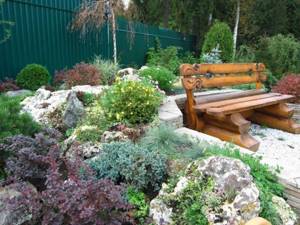
Option for decorating a stone slide with your own hands.
A platform with smooth contours, strewn with gravel or paved with the same material as the paths, is combined with the rock garden. The recreation area is equipped with rattan garden furniture. For the table, a slab (large slab) of rock is laid on a base of blocks.

A picturesque composition, created using a combination of different types of stones.
Original tables and benches are made from gabions and boards. Such options create a feeling of harmony and integrity. For reading by the pond, you can place a tray on the stones. A stone outdoor fireplace will warm and decorate the area.
What are there
Since alpine slides copy real mountains, they can differ greatly in shape, quantity, size and type of stones, the way they are laid, and also in relief. For example, there are layered stone slides, which are also called “Czech rolling pins.” They differ in the vertical arrangement of layered rocks.
The Czech rolling pin is a striking example of a layered alpine slide
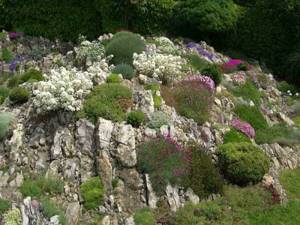
Rocky slides are the most common type of rock garden in our area. This is a small earthen mound on which stones are laid out. The stones are layered or boulders, the space between them is filled with crushed stone, pellets, pebbles or smaller boulders. This will be a rocky hill.
Rocky slide - easy to do with your own hands

But there are those in which the fertile layer occupies a significant area. In this case, single stone blocks stick out from the greenery of the lawn, flowers and small coniferous plants stand out as bright spots. Such plantings imitate alpine lawns.
There are alpine hills with a large proportion of fertile soil

There are alpine ravines. If the site has a similar topography, you can equip it by making an artificial stream. To do this, line the bottom and edges with stones, make a small pond below, from which water is pumped to the top of your “cliff.”
Scheme of an alpine slide with a waterfall and a pond and a waterfall
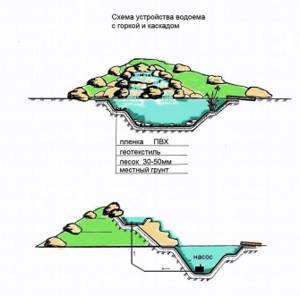
Plant moisture-loving plants along the banks of the stream and pond, and suitable alpine herbs, flowers and perennials on the rocks. Such a structure is, of course, more technically complex; it also requires more costs - a pond, a stream, a slide - everything requires investment. Such complex systems are already considered landscape slides, since they partially change the appearance of the entire site.
And another type of rock gardens is terraces. Dividing the site into terraces is necessary if it is located on a slope. Then a multi-level device is the best solution. Retaining walls are laid to level the ground. They are often made of reinforced concrete and then decorated with boulders. Ground cover plants also thrive on these retaining walls.
Retaining walls can also be decorated with plants
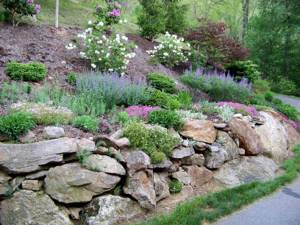
The same principle - the organization of terraces - is used on flat areas, but with a different purpose: to make it more picturesque. In this case, the height difference is created artificially, and this means a large amount of land work.
Rules and care tips
To care for an alpine slide, you do not need special skills. Herbs, shrubs, and flowers develop well in the mulched soil mixture that was provided when preparing the stone flower garden. Plantings properly planted in tiers do not require frequent watering. The “population” of the rock garden is watered abundantly only after planting. The planting substrate for conifers from nurseries contains enough fertilizer for several years. On the Internet you need to look up how to properly water, prune, feed, and plant each plant.

Anyone can create a decorative composition on their site.
Caring for a landscape composition varies by season:
- After the spring melt, the cover is removed from the hill, fertilizing is applied, the gravel mulch is renewed, cracked stones are replaced, loose stones are strengthened, and cracks are filled.
- In the summer, the remains of peduncles and damaged leaves are removed, the shoots are cut off, and the plants are replanted in May or August. Instead of weeding, it is allowed to treat weeds with chemicals. The diluted product is injected into the growing point of the weed with a syringe or onto the leaves.
- In late autumn, the leaves are removed so that the rocky ecosystem does not freeze, and covered with spruce branches. On clay soil, diversions for melt water are made.
- In winter, if there is little snow, they add snow cover themselves.
Note! To build an alpine slide, it is necessary to lay a drainage foundation. It will prevent subsidence of the stone structure and stagnation of water.
To make an alpine hill at your dacha, you need to be prepared for long-term work on preparing the site, planting seedlings, seedlings, and creating conditions for the survival of the populated ecosystem.

Various types of cacti are used in the design of the horizontal rock garden.
Even with independent arrangement of the composition, a lot of money is spent on dwarf trees and stone blocks. To save money on your dacha or country house area, you can create an imitation of a mountain landscape from scrap materials. Stones are chosen along the perimeter of the cultivated fields, seeds of fragrant herbs are collected in the forest meadows, blueberry and lingonberry bushes are brought from the forest.
Landscaping of a summer cottage: (read more)
Periwinkle, ferns, tansy, forget-me-nots, lungwort, crocuses, and snowdrops quickly take root in the new location. Painstaking work and imagination will help you create a unique composition. The main thing is not to overdo it with the decor; the rock garden is not decorated with artificial materials.
Form and types of cascades
The shapes and types of waterfall cascades in a country house can be completely different. The simplest options can be made from scrap materials. Fans of grandiose structures will appreciate multi-stage large structures with fountains, streams and canals.
The choice of cascade type depends on your capabilities and strengths. Calculate in advance how much space you can allocate for the composition and how much money you are willing to spend.
Waterfall layouts can be completely different. How the water flows depends on the stone from which it flows. Falling smooth streams are obtained from stones with rounded, polished edges. Sparkling threads of water will come from the cut stone. Using two stones and two levels of water drainage, an asymmetrical flow will be obtained. In this case, the volume of water in both streams can be the same. If the volume of water is limited, it is better to make it flow around the stone.
